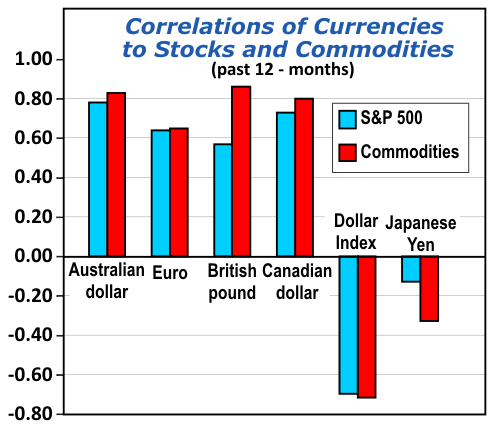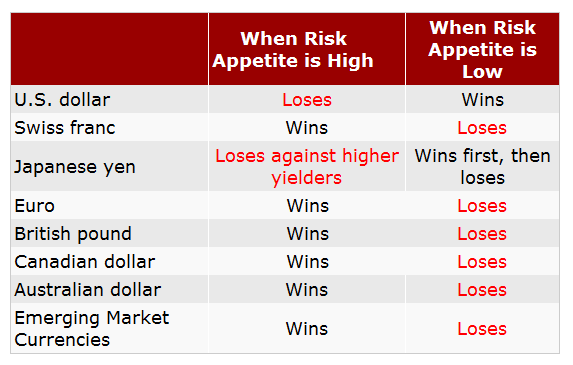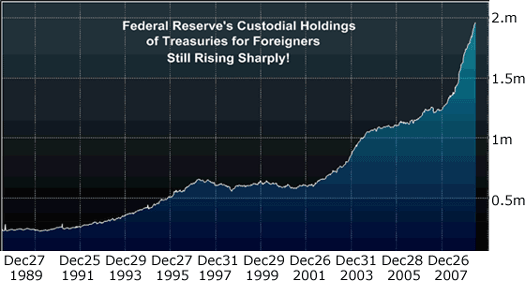Financial Markets Giving Key Clues on Currency Trends
Currencies / Forex Trading Jul 12, 2009 - 03:37 PM GMT Bryan Rich writes: The financial markets have been highly inter-related since the current crisis unleashed fear and uncertainty starting in late 2007. And investors around the world went running for the doors … out of risky assets and into safety.
Bryan Rich writes: The financial markets have been highly inter-related since the current crisis unleashed fear and uncertainty starting in late 2007. And investors around the world went running for the doors … out of risky assets and into safety.
So when we want to find clues about the direction of currencies in this market environment, we just need to take a look at what’s happening in stocks and commodities.
Both of these markets have rolled over. And the relief rally of the past four months appears to have run its course.
As a result, currencies like the euro, the Australian dollar, the British pound and emerging market currencies have started their fall as well.
My chart below shows the tight relationship that currencies have had with stocks and commodities over the past 12 months …

The reason these market relationships remain tight is because all of the risks that drove these “crisis correlations” still loom:
- The housing market is still a major problem with no relief in sight.
- The same financial system that was staring into the abyss of total collapse because it was buried under billions of dollars in toxic assets is still the not-so-proud owner of those toxic assets.
Now …
- 6.8 million Americans are out of work,
- Another 18 million are underemployed,
- And those who have jobs are working fewer hours.
These conditions make a recovery in consumption an unlikely achievement, which makes recovery forecasts very vulnerable to disappointment.
And officials, though promoting estimates for a recovery in 2010, are hedging themselves with public warnings saying …
Beware of “Downside Risks”
The Organisation for Economic Co-operation and Development (OECD) stated: Substantial downside risks remain, especially if global risk appetite were to falter.
The World Bank declared that: The world economy remains unusually uncertain.
The International Monetary Fund (IMF) said: The forces pulling the economy up are still weak.
And the G-8 reported that it was: Premature to reverse world economic stimulus.
The bottom line: The global economy is mired by risks that could easily divert recovery and send things into further depths of contraction. That means risk aversion is, and will be, the overwhelming theme in markets, which makes the risk-taking interest of recent months merely opportunism.
With this said, the below table shows what you can expect from the currency markets for the foreseeable future …

As this table suggests, when crisis strikes, investors flee global stocks, foreign direct investments, and foreign bonds in favor of the safety of U.S. dollar-denominated assets.
In fact, that’s exactly what happened when the financial crisis kicked off and it became clear that the rest of the world would suffer from the reverberations of the bursting U.S. housing bubble, and the subsequent financial crisis.
However, this trend gradually retraced over the past four months … optimism about the prospects for recovery gained momentum and so did risk appetite.
Now, Risk Aversion Is Coming Back …
Stocks are breaking down again. The S&P 500 is down 9 percent in just 18 trading days. Crude oil has fallen nearly 20 percent in six trading days.
The commodities rally looks exhausted, too. China went on a stimulus-package-induced commodities binge. China’s imports of iron ore in May were the highest on record dating back to 1999. But now that’s subsiding.
The Baltic Dry Index, a good gauge of global demand, has been falling for seven straight days.
What about currencies?
 |
| Dollar alternatives don’t exist, particularly in a highly fragile global economic recession. |
As expected, currencies are following suit to the downside. The euro, the pound and the Australian dollar have all breached key technical support and are now in decline. And higher risk carry trades, funded by the favored Japanese yen, are being reversed aggressively.
As for emerging market currencies, this week the Russian ruble experienced its biggest fall in five months. The last time the ruble was falling at this rate, the Russian central bank was in the process of exhausting 220 billion dollars in foreign exchange reserves to defend the value of the ruble.
So with risk aversion picking up, the U.S. dollar’s “least ugly” status comes back into focus, and the dollar benefits.
And despite all of the debate about the future of its reserve currency status, viable dollar alternatives don’t exist. Particularly in a highly fragile global economic recession.
I repeat: The U.S. dollar’s reserve currency status remains healthy. The share of dollars in global foreign exchange reserves increased to 65 percent in the first quarter of this year, the highest since 2007. And the Federal Reserve’s custodial holdings of U.S. Treasuries for foreigners don’t show any signs of slowing.

Source: Bloomberg
That’s not all … on a relative growth basis, the U.S. economy is now expected to lead in a global economic recovery, albeit a weak and fragile recovery scenario.
According to the IMF, in 2009 the U.S. will have among the smallest economic contractions of developed market economies at 2.6 percent. Meanwhile Japan is expected to contract 6 percent, the UK by 4.2 percent and the Euro area by 4.8 percent.
And in 2010, advanced and emerging economies are expected to experience some growth, with one exception … the Eurozone.
The euro has gained 15 percent against the dollar since March. But the relative underperformance of the Eurozone economy makes the euro a likely candidate for another steep fall.
So my suggestion for you today is: Beware of downside risks.
Regards,
Bryan
This investment news is brought to you by Money and Markets . Money and Markets is a free daily investment newsletter from Martin D. Weiss and Weiss Research analysts offering the latest investing news and financial insights for the stock market, including tips and advice on investing in gold, energy and oil. Dr. Weiss is a leader in the fields of investing, interest rates, financial safety and economic forecasting. To view archives or subscribe, visit http://www.moneyandmarkets.com .
Money and Markets Archive |
© 2005-2022 http://www.MarketOracle.co.uk - The Market Oracle is a FREE Daily Financial Markets Analysis & Forecasting online publication.



